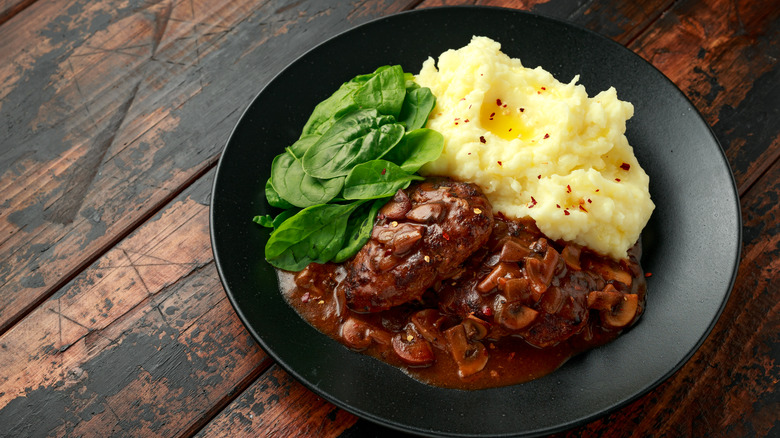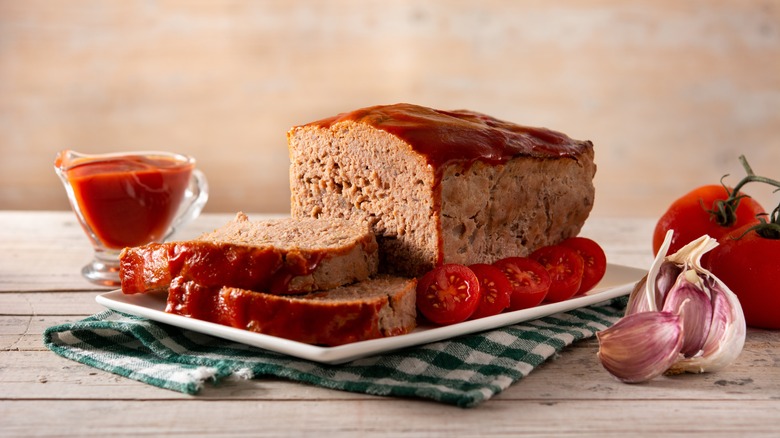Salisbury Steak Vs. Meatloaf: What's The Difference?
You may think of Salisbury steak as a bunless burger with brown gravy and meatloaf as a slice of baked ground meat mixed with a binder and seasonings. But there's more to each dish. Although both dishes are made of ground meat, that's pretty much where the similarities end. But first, let's consider the traits they share. Both meatloaf and Salisbury steak are considered original American dishes and were main courses in classic TV Dinners. TV dinners hold a place in the American heart. The Lazy Dog restaurant group in Colorado tapped into that sentiment during COVID quarantine by serving TV dinner-style dinners as a carry-out option. The number one requested meal was Salisbury steak (per 5280 Magazine).
The Atlantic describes the meatloaf as an "American innovation," however, there's a ground meat recipe in "De Re Coquinaria," a cookbook written by Apicius around 400 AD. While The New York Times Magazine presents the origin of Salisbury steak as the French preparation, biftek haché. Still, the recipe we associate with Salisbury steak originated in the United States. Ultimately, both dishes are classic American comfort foods. The Washington Post praises Salisbury steak's comfort quotient as "simple, uncomplicated and familiar." In the same vein, Culinary Culture touts meatloaf's comfort food status and names several restaurants whose chefs are tweaking the classic with everything from grass-raised bison to a meatless loaf of black beans and quinoa.
Salisbury Steak
Smithsonian Magazine tells us that "muscle pulp of beef" was the first name of the dish that would become known as Salisbury steak. It was created by, you guessed it, Dr. James H. Salisbury, as a meal for convalescing Civil War soldiers. Dr. Salisbury was a firm believer in food as medicine. The doctor served soldiers with chronic diarrhea a dish made of chopped beef thoroughly cleaned of all connective tissue as a broiled patty (per Eat Flavorly). Their cooking methods are one of the ways meatloaf and Salisbury steak differ. Salisbury steak is fried or broiled, while meatloaf is baked.
Food Reference explains that Dr. Salsibury suggested serving the cakes with butter, salt and pepper, Worcestershire sauce, and lemon juice. Thus the first recipe for Salisbury steak was born and eponymously named. Another difference, generally Salisbury steak is topped with mushroom gravy. In comparison, meatloaf is most commonly sauced with ketchup. Incidentally, in 1888, Salisbury published a book, "The Relation of Alimentation and Disease," with his findings from thirty years of research. The book promoted extensive meat eating and vilified vegetables. According to AZ Dietitians, it kicked off one of the United States' first low-carb fad diets.
Meatloaf
Meatloaf has its own storied history. The Atlantic suggests it's no coincidence that meatloaf recipes started appearing in American cookbooks during the late 1800s, shortly after German inventor Karl Drais invented the meat grinder. Meatloaf's basic premise, making pricey meat go further with additions of cereals, and vegetables, made it a perfect fit for families navigating the Great Depression. Furthermore, The Atlantic shares that in the 1950s, many women returned to the kitchen after working away from home during World War II. The Washington Post relays that meatloaf's popularity was partly due to its versatility. It was a frugal, filling meal that a cook could easily make their own. A notable difference between meatloaf and Salisbury steak is the variety of meatloaf recipes available, suggesting everything from wrapping it in bacon to vegan versions made of nuts and mushrooms.
Furthermore, meatloaf frequently uses a blend of meats, while recipes for Salisbury steak are generally made with beef unless you are purchasing a pre-made Salisbury steak. The USDA requires Salisbury steak to be 65% meat, and a quarter of that can be pork. Regardless of their differences, we think most can agree that a dinner of well-made meatloaf or Salisbury steak makes a delicious, comforting meal.


